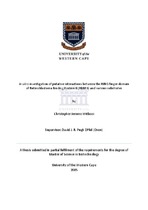| dc.contributor.advisor | Pugh, David J.R. | |
| dc.contributor.author | Witbooi, Christopher Jerome | |
| dc.date.accessioned | 2016-12-07T12:27:08Z | |
| dc.date.available | 2016-12-07T12:27:08Z | |
| dc.date.issued | 2015 | |
| dc.identifier.uri | http://hdl.handle.net/11394/5347 | |
| dc.description | Masters of Science | en_US |
| dc.description.abstract | Retinoblastoma Binding Protein 6 (RBBP6) is a RING finger-containing protein which plays a critical role in the 3'-end processing of mRNA transcripts. It is a constituent of the human pre-mRNA processing complex but also interacts directly with core splicing-associated proteins. RBBP6 also interacts with both major tumour suppressor proteins p53 and pRb and is known to play a critical role in suppression of p53 during development, in cooperation with MDM2. Through its RING finger it
interacts with the C-terminus of the oncogenic protein Y-Box Binding Protein 1 (YB-1) both in vitro and in vivo, catalysing its ubiquitination and degradation in the proteasome. YB-1 is closely associated with tumour progression, poor patient prognosis and chemotherapeutic resistance, making it a promising target for therapeutic intervention. Unpublished data from our laboratory suggests that RBBP6 is able to poly-ubiquitinate YB-1 in vitro, using UbcH1 as the ubiquitin- conjugating enzyme (E2). This study aims to identify RBBP6 RING protein-protein interactions involved in the down regulation of YB-1 by RBBP6. These interactions include the C-terminal fragment of YB-1 (substrate), MDM2 (E3) and UbcH1 (E2). The C-terminal fragment of YB-1, denoted YB-1₂₂₀₋₃₂₄, was successfully cloned and
expressed in bacteria and demonstrated to interact directly with the RBBP6 RING finger domain in in vitro affinity pull down assays. This is in good agreement with our unpublished data that RBBP6 is able to ubiquitinate full length YB-1 as well as the YB-1₂₂₀₋₃₂₄ fragment. UbcH1 was successfully expressed and shown to interact directly with RBBP6 RING in in vitro affinity pull down assays. This is also in agreement with our data showing that RBBP6 is able to ubiquitinate YB-1 using UbcH1 as E2. ¹⁵N-labelled samples of RBBP6 RING was successfully expressed in bacteria and used to investigate the putative interaction with UbcH1 in NMR-based chemical shift perturbation assays. However no interaction was observed, possibly because the sample of UbcH1 was subsequently found using mass spectrometery to be partially degraded. GST-tagged RBBP6 RING was able to precipitate MDM2 from HeLa lysate. This extends previous reports that full length RBBP6 and MDM2 interact directly and play a role in the suppression of p53 during development. The result was validated by showing that GST-MDM2 was able to precipitate RBBP6 RING in in vitro. This study includes a side project which involved the cloning and expression of DWNN-GG. GST-HADWNN-GG was successfully cloned and expressed in bacteria. An HA tag was included immediately upstream of DWNN-GG for immunodetection using anti-HA antibodies; the construct was designed in such as way that it could be re-used to generate HA-tagged versions of existing constructs cloned into pGEX-6P-2. The above findings lay the foundation for future structural and functional studies of the involvement of RBBP6 in regulation of the cancer-related proteins p53 and YB-1, which may have far-reaching consequences in the fight against cancer. | en_US |
| dc.description.sponsorship | National Research Foundation (NRF) | en_US |
| dc.language.iso | en | en_US |
| dc.publisher | University of the Western Cape | en_US |
| dc.subject | Retinoblastoma Binding Protein 6 (RBBP6) | en_US |
| dc.subject | Cancer | en_US |
| dc.subject | Ubiquitination | en_US |
| dc.subject | | en_US |
| dc.subject | Polymerase chain reaction | en_US |
| dc.subject | Multidrug Resistance-Associated Proteins | en_US |
| dc.title | In vitro investigation of putative interactions between the RING finger domain of Retinoblastoma Binding Protein 6 (RBBP6) and various substrates | en_US |
| dc.type | Thesis | en_US |
| dc.rights.holder | University of the Western Cape | en_US |

